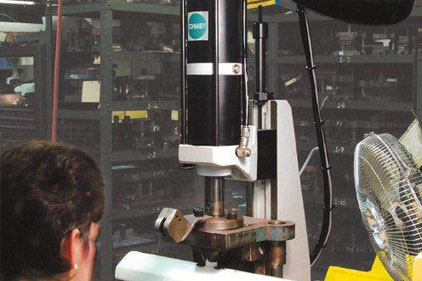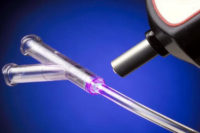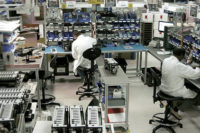From its St. Louis, MO, headquarters, Dazor Manufacturing Corp. produces task lighting and magnifier products used in medical and other applications. The company’s most popular line of task lights is the Classic Series.
Prior to 2006, Dazor used a conventional press and die to join the task light’s socket swivel and shade. But this method often produced inconsistent pressing, preventing Dazor assemblers from properly seating the socket swivel to the shade and meeting company quality control standards. “An average of four out of 10 shades would need to be reworked, including stripping the paint, repainting and refinishing,” says Jeff DeProw, manufacturing engineer at Dazor. “One out of 10 also would be scrapped. These numbers were unacceptable.”
The challenge for Dazor was, and is, assembling the components within a demanding tolerance of ± 0.002 inch. The proper amount of press force has to be applied in a highly controlled manner or the swivel-and-shade assembly will either be too loose or too tight, causing the paint to chip off.
Dazor turned to Schmidt Technology Corp. to meet the challenge. For the last six years, the medical-device manufacturer has used a Model No. 25.100.2 direct-acting air press to join the light’s socket swivel and shade.
Dave Zabrosky, North American sales manager for Schmidt Technology, says the press generates up to 2,750 pounds of force throughout the entire ram stroke at 85 psi of air pressure. Model No. 25.100.2 has a fully adjustable ram stroke of 1.18 to 3.94 inches.
To accommodate Dazor’s six Classic Series lamp models, the press ram stroke is infinitely adjustable in 0.0008-inch increments. To accommodate the new press, Dazor’s tool and die shop personnel slightly modified the existing die. However, the direct-acting air press has virtually eliminated Dazor’s scrap rate and number of reworks.
Curving Cranial Implants
For the past 10 years, a medical-device manufacturer has been using the 5000L-22 pneumatic press by Fancort Industries Inc. to bend cranial implants. The implants are made of stainless steel or titanium and range in size from a pencil eraser to 2 inches in diameter. Volume is several thousand implants per week.
The company had tried another supplier’s pneumatic press, but it performed inconsistently and lacked cleanliness. Equally important, the manufacturer wanted the 5000L-22 because it comes with a programmable timer that ensures consistency, says Robert Antonelli, vice president of Fancort Industries. The timer for the press dwell is set, then the press stroke is activated via an OSHA 2 hand safety system.
A cart of implants is wheeled to each workstation. The worker retrieves a part, places it in the press and activates the press by using a two-hand anti-tie down switch. Cycle time is 2 seconds. Curved parts are placed in a bin, then wheeled to another work station for further assembly.
Clinching Fasteners Into PC Boards
A New England-based manufacturer has been making magnetic resonance imaging (MRI) equipment for many years. The MRI equipment creates images that provide good contrast between the different soft tissues of the body.
Each piece of equipment features several printed circuit boards (PCBs), which are crucial to the machine’s proper and effective operation. Several years ago, the manufacturer brought PCB assembly in-house and used arbor presses to build PCBs.
Unfortunately, the arbor presses did not provide enough force control, resulting in many broken PCBs. A few years ago, the company replaced the arbor presses with Pemserter Series 4 presses made by PennEngineering.
These presses insert specially designed fasteners for PCBs, says John McLaughlin, North America sales manager for the Pemserter division of PennEngineering. Made of stainless or carbon steel, the fasteners include studs, standoffs, nuts and spacers. The manufacturer installs tens of thousands of fasteners annually.
Boards with holes in them are brought to each assembly workstation. Each board sits in a special rack that holds the board vertically.
The worker removes the board from the rack and presents it horizontally to the press for hardware insertion. The worker inserts a fastener in a hole, then activates the press by foot.
Press force is 400 pounds. Cycle time is 2 seconds. If a board requires more than one fastener, the worker turns the board and inserts another fastener before activating the press.
Finished PCBs are placed back in the rack that holds the boards vertically, then moved to the next workstation for further assembly.
No Longer An Emergency Situation
Since 2010, a central Midwest medical-device manufacturer has been using several JP Series 4 servo-driven electric presses to make surgical cutting tools used in emergency rooms. The manufacturer operates eight of the presses, made by Janome Industrial Equipment USA Inc., two shifts per day, seven days per week.
Previously, the manufacturer used pneumatic arbor presses, says Phil Cohen, national sales manager for Janome Industrial. However, they often were inaccurate, resulting in many unusable tools that had to be scrapped.
Before assembly begins, a worker scans the bar code of the correct fixture and attaches it to the press. The PLC automatically calls up the associated program, and Janome’s SPC software is ready to collect ram force and distance data.
Next, tool housings and other components are conveyed to the assembler. The assembler places the components in the fixture, then activates the press using its two-hand switchbox. The press joins the components in 5 to 6 seconds. The worker removes the subassembly, which is conveyed to the next workcell for further assembly.
Creating One Opening at a Time
Medical device parts often require degating, which is the removal of unwanted material that’s leftover from injection molding. One New Jersey-based manufacturer of medical products no longer needs to degate the front plate housing of its defibrillator thanks to a pneumatic press.
The company uses a Direct-Aire 400 pneumatic press made by AIM-Joraco to create four clean openings in the front plate housing: three 1-inch-wide holes and a 2-by-3-inch rectangle. The front plate housing is made of ABS plastic, curved and measures 8 by 10 inches, says Andy Lewis, president of AIM-Joraco.
Each hole and rectangle area to be punched out is carefully, but quickly, centered under the press ram. Upon activation, the press ram uses 500 pounds of force to create the circle or rectangle in 2 to 3 seconds. The worker must flip and re-center the front plate housing to create each additional opening.
Consistent Cartridges
A supplier for a North Carolina-based manufacturer uses a DA150 direct-acting pneumatic press from BalTec Corp. to seal cartridges that hold medication used for chemotherapy. The supplier began using the DA150 press in 2010 and currently operates 15 presses.
“Improving consistency in the assembly process was the main reason the supplier chose the DA150,” says Charles Rupprecht, executive vice president of BalTec Corp. “Another benefit has been a lower scrap rate.”
A key feature of the DA 150 is an energy-saving tandem cylinder. This type of cylinder optimizes compressed air consumption because the return stroke is performed by only one cylinder chamber.
The DA 150 has a force capacity of 1.5 kilonewton and a 80-millmeter working stroke. Table size is 100 by 65 millimeters.
Sealing the cartridges, which are made of plastic or a polycarbonate material, is a manual process. Approximately 5,000 cartridges are sealed each day, five days per week.
All Plugged Up
Many people require oxygen-dispensing machines to breathe. For the past several years, one IL-based manufacturer of medical devices and press supplier Promess Inc. have worked together to improve the quantity and quality of flow valves used in oxygen-dispensing machines.
The medical-device manufacturer uses the Promess EMAP05/200/200 (5 kilonewton) electromechanical press to insert a plug into the top of a tube in the valve. The plug ensures proper air flow volume through the valve.
“The tube component is a hollow piece of stainless steel that’s 3 inches long and less than ½ inch wide,” says Glenn Nausley, president of Promess. “One end of the tube has a transducer, while the other end is open.”
Valve assembly is an automated process. A 3 millimeter-wide hole is drilled into the top of the tube, which is fed into the press. An air hose is connected to the open end of the tube, and air is blown through the tube.
The EMAP press then inserts a plug into the top hole and automatically stops when the correct air flow volume has been reached, per the transducer. Average cycle time is 45 seconds to 1 minute.
“Previously, the manufacturer used electro displacement machining (EDM),” says Nausley. “This method is precise, but it’s also very slow.”
The EDM process created holes in 100 valves simultaneously—but it took about 8 hours. Nausley says the EMAP press can handle 100 valves in about one-fourth the time and costs much less.




